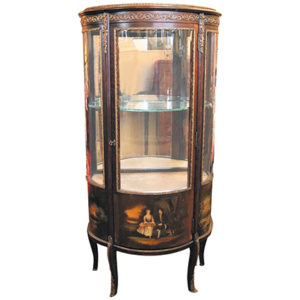 By Anne Gilbert
By Anne Gilbert
Whether your collection is large or small, over the century’s furniture was made just to display it. It began in ancient Rome with royalty and the wealthy who used table tops to show off small treasures. However, it was more common for them to use an entire room devoted to their collections. Wealthy Greeks built rooms to house their treasured books that were then placed in small cupboards. Not too different than today when rooms of corporate offices often display collections related to their businesses or just because the CEO collects them. During the middle Ages open-shelved cupboards were designed to hold family silver. Before this time such valued objects were hidden away for their own security.
Collections became status symbols during the Italian Renaissance that lasted from the middle of the fourteenth century till the end of the sixteenth. For the first time special types of furniture were designed to show them off. Among them, the credenza that later evolved into the sideboard. Sometimes it used the base topped with an open cupboard to show off more collections.
Sixteenth century Spaniards used a drop front writing desk, the “Vargueno” that sat on either a trestle type base or cupboard base. The box itself was heavily gilded or polychromed.
King Louis 1V owned the first display showcase for his diverse collections of everything from porcelains to silver. The showcases usually rested on stands. The most elegant bases were in the form of gilded figures. By mid 17th century Oriental designs and lacquered pieces were imported from the Far East.
In England Thomas Chippendale designed massive, library breakfront bookcases in the Gothic style. With varying designs it has been used to display favorite things since the mid-18th century.
Victorian collectors in England and America collected on a more humble scale, though their collections often covered every visible space. By the mid-19th century a curio cabinet was apt to be a towering, heavily carved “Etagere,” combining upper and base mirrors with shelving. Rosewood was the favored wood during the Rococo revival period. Smaller hanging “what-not” shelves were also popular.
The “vitrine” originally a French, small cabinet on legs, with three sides of glass was revived during the Art Nouveau period, with exaggerated, curving lines.
CLUES: The painted, French vitrine, Victorian etageres and court cupboards are still being reproduced. Those made in the early part of the 20th century have some age on them by now and can confuse beginning collectors. More recent reproductions are showing up from Far East countries.
Always check the construction and don’t forget to “sniff” the wood. New wood has a fresh smell.















Follow Us